|
Season 2 • Episode 14 - July 25, 2023
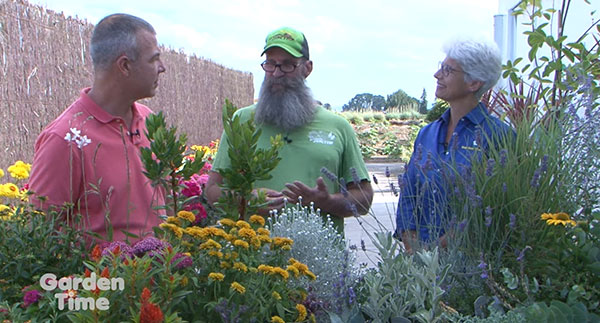
The last few summers have been tough
on the garden. We had an extended period of warm dry
weather that left many plants in the garden dying of
thirst. A lot of people are now looking at
drought-tolerant plants as part of their regular
gardens. Well, we found a place where you can actually
see a large variety of drought-tolerant plants in a
garden and check out how they perform. We stopped by
Blooming Junction (503-681-4646) at 35105 NW Zion Church
Road, near Cornelius and chatted with Ron the manager
about xeriscaping and to see a selection of plants that
do well with little or no water.
We first talked about xeriscaping and what that means.
The basic definition of xeriscaping is landscaping or
gardening in a style that requires little or no watering
or irrigation. This refers to the types of plants you
use and how you landscape your garden. So it isn’t just
about drought-tolerant plants, it could also include the
use of lawn, mulches and irrigation types. The first
thing to consider is to have a plan and to know your
garden. Where is the most light or shade and at what
times of the day will you get sun exposure? Does the
area you are considering have access to water or a
sprinkler system? How much time do you have to take care
of your garden? All these things need to be considered
before you head to your local garden center. After you
have that basic information in hand, Ron had a group of
gardening principles to consider when you are designing
a xeriscape garden.
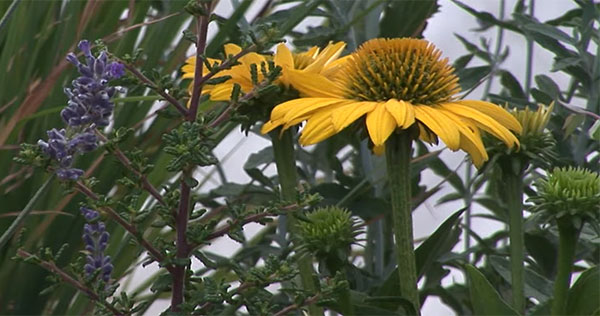
First, look for plants that like the same growing
conditions. Picking plants that have the same water
requirements, the same lighting needs and the same
fertilization requirements will go a long way to making
sure that they survive and thrive. It would be a good
idea to walk around your garden center with a cart that
represents the area you are planting. Considering the
requirements of the area in your garden, start
assembling the selection of plants on that cart. Some
gardeners adopt the same rules for building a garden bed
as they would for designing a container garden. The idea
of ‘Thriller, Filler, Spiller’ works well for your
garden beds too. The thrillers are the large plant
specimens. These could go at the back of your garden
beds. The fillers are the medium sized plants that go in
front of those and the spillers are the lower ground
cover types of plants to soften the leading edge of your
garden. This plant selection process can be helped by
the garden center staff if you feel like you need help.
Second, you should consider
your soil conditions. Most drought-tolerant plants like
nutritious and well-draining soil. That could mean that
you need to add compost or other nutrients to your soil.
It is a good idea to get a soil test (check with your
local university extension office for testing in your
area) before you spend any money on amendments. We have
a lot of clay soils in our area. They can be nutritious
but need help with other materials to make them a little
more porous and less like concrete. Remember the plants
that you will be planting and adjust the amendments to
their requirements.
Third, consider your usage of turf and lawns. If you are
going for less water usage, remember that lawns are one
of the biggest water users in your garden. Some people
love that green lawn look, but it takes a lot of water
to get and keep those grass varieties happy and healthy.
Consider a small lawn or use an alternative like sedums
and wildflower/clover mixes that use less water. You can
also do other things like raising the blade on your
mower and cutting less often to help save water.
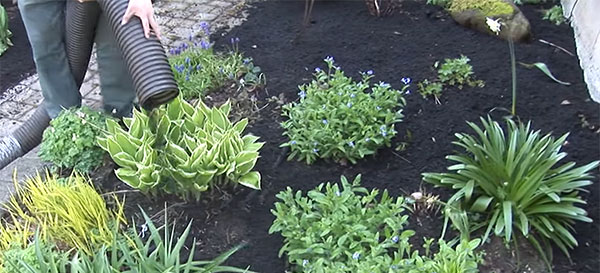
Fourth, irrigation. Since you have placed plants with
similar needs together, you can now adjust the amount of
water that goes in those areas. Remember that you will
need to use a little more water in the first year of
planting to help those young plants get established, but
once their roots are firmly in the ground, you can start
reducing watering in the second year. Some people like
to hand-water, but you should also think about adding a
watering system to your garden plans. A system on a
timer is great and can help you control the amount of
water used in your garden. Once you have the system in
place, including drip irrigation, then keep checking the
system to make sure it is doing a good job. You want to
be sure the heads are not blocked and that the water is
going where you want and not watering the pavement. A
system will also allow you to deep water, which is
better for your plants. A deep watering twice a week
will get the plant to send more roots deeper into the
soil for that water. If you do shorter watering, more
frequently, then the roots will stay neer the surface of
the soil and the plant will be more susceptible to
drought stress.
The next tip was about the use of mulch. This mulch can
take many forms; bark, compost, top soil or even -- in
the case of some gardens -- crushed concrete or gravel.
Mulch helps retain moisture, suppress weeds and maintain
an even temperature at the root zone. It can also look
nice too.
Finally, maintain your garden once you have planted it.
This could mean that you need to move plants if they
don’t perform well, changing watering patterns or
pruning plants to make room for others and to help shape
their growth, and keeping ahead of the weeds.
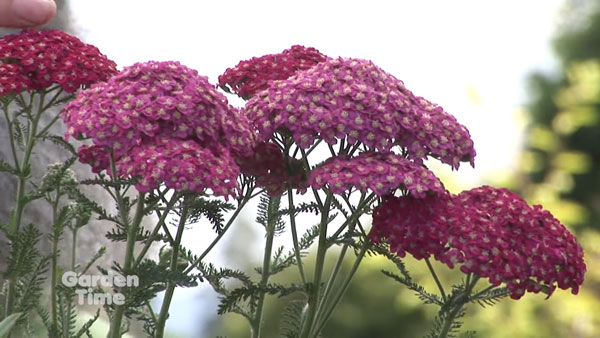
Now, for some, the thought of a drought-tolerant garden
brings images of brown and bare plants and barren
landscapes. However that is not true. Next we talked
about a bunch of plants that Ron had assembled that were
looking great in the mid-summer heat and would do well
in our climate and conditions. Rudbeckia was our first
plant. This is a tried-and-true plant for the
drought-tolerant garden. This plant, Goldstar, was a
great representative of the group. It sends up tons of
‘sunflower-like’ blooms and just keeps blooming and
blooming. It also has some varieties that have different
colors and bloom styles, like a second one we saw called
‘Lion Cub’ with mum-type flowers. Next we looked at a
yarrow. These are pretty recognizable with flower
clusters that look like mini tree tops. The color
variety has increased in recent years too. Originally
just covered in yellow blooms, the newer colors include
pinks, oranges, reds and purples. The one we featured
was Saucy Seduction which has deep magenta and pink
colors in the blooms. They love full sun and are a
favorite of butterflies and bees. Gaura (wind flower)
‘Whirling Butterflies’ was next. The blooms on this one
look like little fishing poles waving in the wind with
delicate white blooms at the ends of the poles. Though
this one is quite tall, there are other varieties that
are shorter and more compact. Other varieties also come
in different bloom and foliage colors. A favorite of
Ron’s was next with a rockrose, also known as Cistus,
called ‘Orchid Rockrose’. The one we featured had pink
and burgundy blooms. They are very hardy and are known
to be deer-resistant, and they get big, 6 by 6 feet. If
you want something a little bigger, we had an Arbutus
(Strawberry Tree). The Arbutus is called a strawberry
tree due to the small round red fruit that appears later
in the season. They are edible, though most people don’t
know that. It is in the Manzanita family, which makes it
very easy to grow in our area. We then moved to some
less hardy plants for this area. The first was a
Lantana. The Lantanas are great in your summer beds,
though you can have them winter-over if you keep them in
a container and move them inside for the winter. They
have very cool blooms with clusters of tiny flowers that
start out bright peach and then turn a deep pink. We
have found them to be a little bit of a prima donna in
the garden; they wilt if they get even a tiny bit dry,
but then perk back up with a cool drink. Another annual,
drought-tolerant, plant is the Celosia (Cock’s Comb)
‘Orange Fire’. The blooms on these are a tall cone of
color, reddish/orange on this plant, that look like
tongues of flames. Then we focused on a group of sedums
and succulents. This family of plants are great for the
dry summer garden. They come in all sorts of shapes and
sizes, but all of them do well with little or no water
once established. There are even some that are small
enough to become lawn replacements if you want to do
that.
After focusing on colorful blooms, we then moved over to
Judy’s side of the table with silver and white foliage
plants. The first one was a cushion bush, which
resembled a silver tumbleweed with its fine foliage and
tiny flowers. The tiny pom-pon flowers bloom a bright
yellow, which will really make this pop in the garden.
Another silver foliage plant was the Senecio with leaves
that are a little waxy. The plant will really glow in
the garden when it gets taller, though it looks great at
any size. A small silver foliage plant was the silver
lotus. It has tiny soft leaves that beg to be touched.
It does get a tiny beak-type flower which gives it
another common name of ‘Hairy Canary’. A unique plant
was next, a Parahebe perfoliate. This plant looks like a
small eucalyptus, but it isn’t even in the same family.
In fact, it isn’t even in the Hebe family. This one will
reward you with tall purple flower spikes. The next
plant was a Ceanothus ‘Dark star’. This plant has tiny
waxy leaves and gets really tall (so give it room) and
is covered with clusters of tiny purple flowers that
bees go crazy for. It is a deer-proof plant, as well.
Lavenders were next on the list and are a favorite of
many gardeners already. ‘Ana Luisa’ was the one we were
looking at and it was in full bloom with tall flower
spikes of purple flowers. This one had silver foliage
and was smelling great. Remember to not water this one
too much (it is a drought-tolerant plant) and to prune
it down after it blooms to help it keep its shape.
Another plant with tall purple flowers is Russian Sage
‘Little Spire’. It is called a sage, but it isn’t a
sage. It will get really tall, but the silver foliage
and lavender colored blooms make it a showcase plant in
your garden. The star of the summer garden are the
Echinaceas. These plants now come in lots of different
flower colors. We had a bright yellow and a smoky/burnt
red to represent this great family of plants. These are
pollinator-friendly plants and are very hardy in our
area. Just about every garden needs grasses too. We had
a couple to look at that were looking good and even with
the light breeze we were having, were waving in the
wind. Blue Stem and Switch Grass are well-behaved. A lot
of grasses will spread and take over an area, but these
hold their ground and don’t wander too much. The motion
and texture are a great addition to the garden. We then
ended on a tall tree for the garden, the Serviceberry.
There are shorter varieties that can become shrubs, but
this one was a larger tree form. It will have tiny white
flowers followed by red berries for the fall. These were
all great plants for the dry summer garden, but we also
wanted to see how they perform in the real world. Lucky
for us they have a drought-tolerant display garden in
the front of the store.
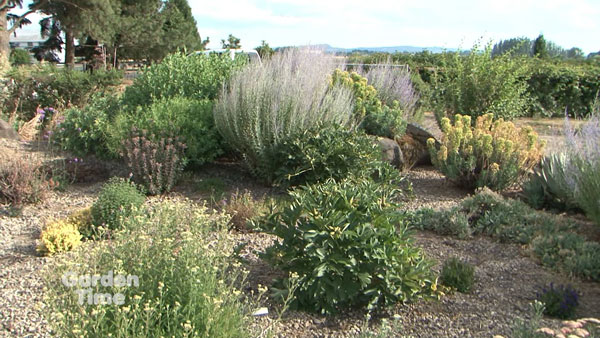
After the break we moved to the front display garden
full of water-wise plants. This garden was planted about
eight years ago. We had featured it on the Garden Time
show right after it was planted and it has really filled
in. In the beginning they started with creating a bed
with a recycled concrete mulch base. This allows for
water to drain quickly through the roots and provide
weed suppression at the surface. Then they grouped the
plants together based on their water needs. Because of
this they only had to water a little bit to help the
plants get started and then they watered only about four
more times during the season during the extreme heat.
Now they water only occasionally, once or twice a
summer, if temps get really hot.
Most of the original plants made it
and some did not. The first plant we looked at was the
cardoon. This plant was huge and really loves the dry,
full sun. It resembles the artichoke, but it is just a
statement plant from the thistle family. Be careful,
these can reseed so keep an eye out for baby plants
popping up in your garden. Another huge plant in the
garden is the olive. There was a large one in the
garden, but because there is not another pollinator in
the garden, this one doesn’t get fruit. It’s a nice
plant that gives your garden a Mediterranean look. Next
to the olive tree was an agave. It was one of the
original plants and it has become huge. The large fleshy
spiked leaves look stunning in the garden. There were
also assorted groundcovers including the Hairy Canary!
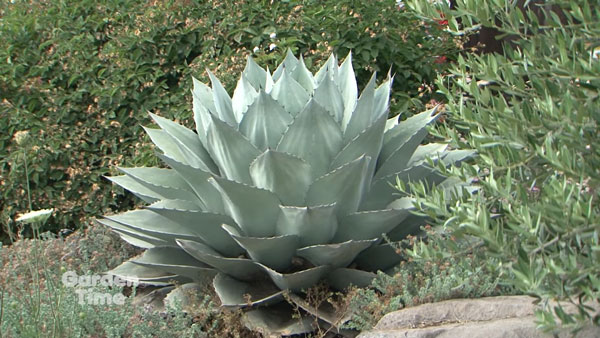
We then moved to the other side of the garden. It was
full of healthy plants loaded with blooms. The Russian
Sage was in full bloom as was the yarrow and a large
grouping of Shasta Daisy. They also had Euphorbia and a
huge example of the Arbutus with its great red bark and
deep green foliage. The garden was a perfect example of
how you can build a garden like this in your yard. If
you want to see how different drought-tolerant plants
look in the garden, you should stop by. Pretty much
everything they sell is a ‘Blooming Advantage’ plant.
They are grown right here in Oregon and every one of
them performs well in the Northwest garden.

PODCASTS
2022
• Return to Current Year Podcast List
 |